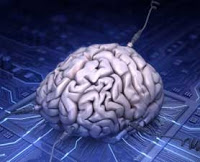 |
| image source |
Nicholas West
Activist Post
DARPA continues to march full steam ahead in its quest to reverse engineer the human brain. On August 14th the military research arm of the U.S government solicited information that could lead to the development of a “Cortical Processor” – essentially a processing system that can simulate the human brain’s neocortex; the area responsible for sensory understanding, thought, and language.
This new request is an extension of its ongoing program to fund research that ultimately seeks to create full-fledged Artificial Intelligence for a range of applications.
So far there has been a slow, but sure merging of hardware and software that is comprehensively attempting to reconstruct the brain by creating computer chips and software that can parallel process information, while consuming very little power, in the same way that humans are able to do.
A look at the full Request For Information, DARPA-SN-13-46 shows some interesting areas of investigation and talent being sought for future developments.
The main focus is stated as “signal processing and data analysis” in “high-bandwidth, noisy, ambiguous data streams.” This would appear to indicate a need for more precise filtering of the massive amounts of intelligence being gathered across the planet.
Currently, massive data storage facilities are being built by the NSA, like the one in Bluffdale, Utah, but so far the data is so voluminous that even current algorithms are most likely producing many false red flags. The government has initiated its Big Data project to set a path “from data to decisions” that includes universities, private corporations, and government agencies working in tandem to seek new ways to fully understand what is being collected in real time, and stored for future examination.
Perhaps some of the limitations are being addressed when DARPA states:
DARPA is examining a new approach based on mammalian neocortex, which efficiently captures spatial and temporal structure and routinely solves extraordinarily difficult recognition problems in real-time. Although a thorough understanding of how the cortex works is beyond current state of the art, we are at a point where some basic algorithmic principles are being identified and merged into machine learning and neural network techniques. Algorithms inspired by neural models, in particular neocortex, can recognize complex spatial and temporal patterns and can adapt to changing environments. Consequently, these algorithms are a promising approach to data stream filtering and processing and have the potential for providing new levels of performance and capabilities for a range of data recognition problems. (emphasis added)
There are four areas that DARPA seeks to address, and is requesting information from those with the following skills:
 Algorithm Developers: Dealing with pattern recognition in real time to analyze streaming data in war environments – “image or speech recognition.”
Algorithm Developers: Dealing with pattern recognition in real time to analyze streaming data in war environments – “image or speech recognition.”
Hardware Developers: Presumably once the algorithms are in place, it’s necessary to create the processing modules which “could optimally communicate with a large subset of other nodes using dense interconnect technology and on-chip network optimizations for the architecture to achieve the connectivity required.” This sounds like much of the language used in creating autonomous drone systems.
Systems Developers: A rather technical description if offered here, but essentially how to construct stable systems that can apply a Cortical Processor system within “mission-critical applications.”
Application Developers: Here is where we can see the vision for real world applications. “Vision and image systems, to sensor fusion and robotic control.” This could be utilized in electronic surveillance, nano-surveillance (sensor networks) and a wide range of robots, including the next gen humanoid robots capable of true artificial intelligence.
DARPA emphatically states that “This is an RFI issued solely for information and new program planning purposes; it does not constitute a formal solicitation for proposals.” They also say that “Although not a neuroscience project per se, it will heavily depend on a variety of neural models derived from the computational neuroscience of neocortex.” Diving through the B.S., the intent is clear. Especially when we look at the other areas of DARPA research taking place within the fields of neuroscience, we see a very clear indication that mind control is a huge component of these developments, not just mind creation. Perhaps the mind control will be put in place for whatever actual humans remain after they get done creating their advanced AI robots and autonomous systems.
All that is needed now are the responders to help build the future computer brain for the military-industrial complex. Yes, those people who might actually enjoy working for the future police state surveillance grid and help build the next generation of the digital matrix prison system.
Any takers?
Full DARPA .pdf can be read here:
https://www.fbo.gov/index?tab=documents&tabmode=form&subtab=core&tabid=450dbc55dfb6deef9c8a2141216faa74
Source:
http://www.networkworld.com/community/blog/darpa-wants-computers-fuse-higher-human-brain-function
Read other articles by Nicholas West
linkwithin_text=’Related Articles:’


Be the first to comment on "DARPA Issues Request For Information to Create a Computer Brain"